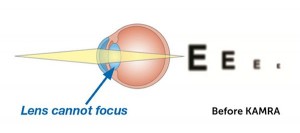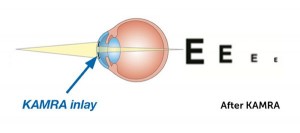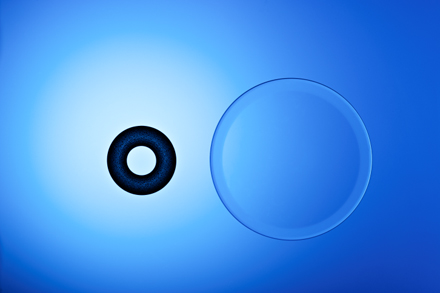KAMRA Reading Vision
Understanding Near Vision Loss
Why is My Near Vision Changing?
In our 40s and 50s, we begin to experience the naturally frustrating effects of blurry near vision. Reading the newspaper, seeing the computer screen or sending a text message becomes a struggle. We end up depending more and more on reading glasses or contact lenses to see up close. This natural loss of reading vision is called presbyopia (prez-bee-OH-pee-ah), and it eventually affects all of us, even if we never needed vision correction before.
What Causes Presbyopia?
The eye’s natural lens is normally elastic and flexible. It works like a camera lens to automatically adjust and focus our vision. This lets us automatically switch our gaze from something near to something far away. Over time, the lens in your eye begins to stiffen. It can’t bend into the right shapes to bring close objects into clear focus. To compensate, you end up moving objects further away to help your eye to focus.
Presbyopia continues to progress over time. For example, someone who is 42 may only notice it when trying to read tiny print in low light. However, someone who is 45 may need to use reading glasses many times throughout the day.
BEFORE: When the natural focusing ability of the eye diminishes, near vision becomes blurry.
How the KAMRA® Inlay Helps
The KAMRA inlay treatment is an eye procedure that restores near vision and frees you from the constant frustrations of reading glasses. The KAMRA inlay sits in the first few layers of the eye known as the cornea. Smaller and thinner than a contact lens, the KAMRA inlay is a mini-ring with an opening -- or pinhole -- in the center. The inlay uses this pinhole to focus light coming into the eye. This restores near vision while maintaining distance vision.
AFTER: With the KAMRA inlay, unfocused light is blocked, making near vision clear
Common Vision Conditions:
How Our Eyes Work
The eye is a tiny organ that measures about an inch long and weighs about 1/4 of an ounce. It is part of a complex system that translates light into images. Light enters our eye through the cornea and into the pupil. The pupil is the black hole in the middle of the iris, the colored part of the eye. Behind the iris is the natural lens. It focuses the light onto the retina, the inside layer of the eye. The retina contains cells that are sensitive to light. The image is then converted into electrical impulses that are sent through the optic nerve at the back of the eye to the brain.
All of this happens continuously and instantly to give us clear vision from near to far distances. But, our eyes don't always work perfectly. Their exact size and shape affect how well they focus light. These differences can cause some of us to have refractive errors such as myopia, hyperopia or astigmatism. In addition, over time, we all lose our ability to focus on near objects. This is a refractive condition known as presbyopia.
Presbyopia
- Presbyopia is the clinical term for near vision loss that starts affecting us in our 40s and 50s
- Over time, the eye’s natural lens becomes too stiff to focus up close
- Print and other nearby objects become blurry
Myopia (Nearsightedness)
- Ability to clearly see near objects, but distant objects are blurry
- Occurs when the cornea is too rounded or steep, or the eyeball is too long
- The eye’s refractive power is too strong
Hyperopia (Farsightedness)
- Ability to clearly see distant objects, but nearby objects can be blurry
- Occurs when the cornea is too flat or the eye is too short
- The eye’s refractive power is too weak
Astigmatism
- Light coming into the eye is focused inconsistently
- All objects are stretched or distorted
- Occurs when the cornea has an irregular oval shape
- Can occur simultaneously with nearsightedness or farsightedness
KAMRA Inlay:
Discover the KAMRA Inlay
Enjoy Life without Depending on Reading Glasses
The KAMRA inlay treatment is an eye procedure that restores near vision and frees you from the constant frustrations of reading glasses. It is ideal for active people looking to no longer depend on reading glasses or contact lenses for their everyday activities. The KAMRA inlay:
- Restores everyday vision so you can see text messages, a computer screen and the time on your wrist watch, without the frustration of reading glasses
- Provides a natural range of vision – from near to far – without blurry zones
- Offers a long-term solution that will help you enjoy clear near vision over time
Watch this video to learn more about the KAMRA principle or
download our Patient Brochure.
VIDEO
How the KAMRA Inlay Works
The KAMRA inlay sits in the first few layers of the eye known as the cornea. Smaller and thinner than a contact lens, the inlay is a mini-ring with an opening - or pinhole - in the center. This pinhole allows only focused light to enter your eye. The KAMRA inlay is placed in only one of your eyes, allowing you to see up close, while maintaining your distance vision in both eyes. Your non-KAMRA eye is left untouched. Working together, the eyes allow you to see near to far. This is unlike monovision laser vision correction, which corrects one eye for near and one eye for distance and does not last over time.
What to Expect
The Procedure
From start to finish, the KAMRA® inlay procedure will typically take less than 20 minutes. Numbing drops are used to ensure you are comfortable throughout the procedure. You may feel slight pressure while the doctor uses a laser to create a small opening in the first few layers of your eye, known as the cornea. However, it only lasts a few seconds. The inlay is then placed within the opening. Once the numbing drops wear off, your eyes may feel irritated or scratchy and you may also experience excessive tearing or light sensitivity. This is normal. Your doctor will provide medications to help you manage these symptoms. To learn more, watch this short video of an animation of the procedure.
You will not be able to drive home following the procedure so make arrangements beforehand for a ride. You should not drive until your doctor tells you that this is okay.
What to Expect
Recovery
As with any eye surgery, healing is a process. Adhering to your doctor's recovery instructions will accelerate your progress. It is important to remember that the amount and pace of near vision improvement varies by individual. While some patients see an improvement within the first week to a month, others way require additional time to heal. Most patients resume normal activities and return to work within 24-48 hours.
To enhance your recovery and near vision improvement, you should:
- Avoid using your reading glasses
- Take your medications as prescribed by your doctor, including artificial tears
- Keep your follow-up appointments with your doctor
It is typical to experience some fluctuations in your vision in the first three to six months after surgery. This is often a sign of dry eye or your brain adapting to the new vision. These will likely stabilize. The key to success are to be patient with the recovery process and diligent in following your doctor's instructions. This video contains more information about the KAMRA® inlay recovery period.
VIDEO
Keep in mind that some KAMRA patients may still require reading glasses for activities such as reading tiny print or reading in low light. In addition, if the inlay is not centered properly or if the effects are not ideal, your doctor can safely remove the KAMRA inlay.
Download your copy of the KAMRA Recovery Guide
For Important Safety Information, including surgical risks, indications, and considerations and contraindications for use, please refer to https://kamra.com/ safety.











Connect With Us